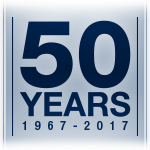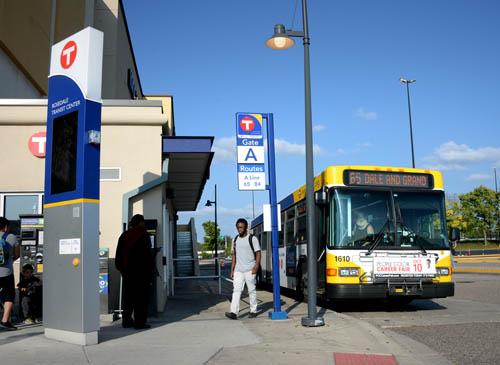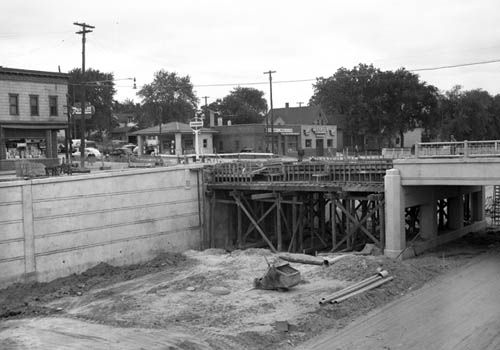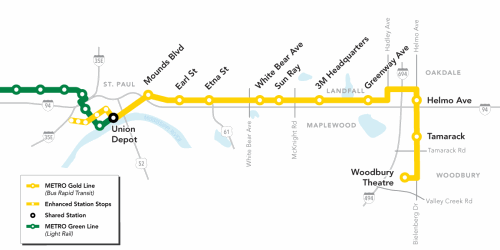 The METRO Gold Line bus rapid transit (BRT) service is scheduled to begin carrying passengers in 2024 between Woodbury and downtown Saint Paul. Like other fixed transitways, the Gold Line It is expected to serve as an economic catalyst, connecting existing jobs with job seekers and stimulating new development—housing, new businesses and new jobs.
The METRO Gold Line bus rapid transit (BRT) service is scheduled to begin carrying passengers in 2024 between Woodbury and downtown Saint Paul. Like other fixed transitways, the Gold Line It is expected to serve as an economic catalyst, connecting existing jobs with job seekers and stimulating new development—housing, new businesses and new jobs.
The region’s marketplace has already proven that transit attracts jobs and investments, notes Washington County Commissioner Lisa Weik. She points to a future station on the proposed Green Line light rail extension in the western metro. “The land around a single stop in Minnetonka had a property value of $8 million in 2014. Today it is $26 million and the line isn’t even built.”
 Development along the existing Green and Blue lines bears out the economic benefits of dedicated transitways. More than $5.7 billion has been invested in 230 new developments on the Green Line between the Minneapolis and Saint Paul, while the Blue line from Minneapolis to MSP airport has seen 142 new developments totaling $3.7 billion.
Development along the existing Green and Blue lines bears out the economic benefits of dedicated transitways. More than $5.7 billion has been invested in 230 new developments on the Green Line between the Minneapolis and Saint Paul, while the Blue line from Minneapolis to MSP airport has seen 142 new developments totaling $3.7 billion.
Large employers seek to locate near transit
Weik says the workforce needs of the East Metro are the one of the most compelling reasons to build the Gold Line. During the last recession, economic conditions led large employers like State Farm and Imation to leave the area. Employers of that size are now specifically listing transit as a criterion for choosing a new location.
“Every day 100,000 commuters leave Washington County to go to work,” she said. “If you live here, you likely don’t work here. Unless you work at 3M, if you have an advance degree you’re driving someplace else.”
METRO Gold Line will serve local neighborhoods
 On its traverse from Ramsey County into Washington County, the Gold Line will run through traditional working-class communities like Landfall, and Saint Paul’s Dayton’s Bluff and Sunray neighborhoods. Twenty percent of the households without cars in the Twin Cities metro area are located within a mile of the new line.
On its traverse from Ramsey County into Washington County, the Gold Line will run through traditional working-class communities like Landfall, and Saint Paul’s Dayton’s Bluff and Sunray neighborhoods. Twenty percent of the households without cars in the Twin Cities metro area are located within a mile of the new line.
Eastside Business Association Director Paris Dunning points to the Gold Line’s Earl Street stop as an excellent example of how the line will serve neighborhoods. Today, a cluster of historic buildings shows where businesses located near the Earl Street streetcar stop when it was built a century ago.
“People walked to the streetcar and went to work, and on the way home they stopped at the butcher’s shop. It can work that way today,” said Dunning.
Robust transit system gives people choices as region grows
By 2040 our region will grow by more than 800,000 people, which means demand for transit service will increase from 100 million rides annually today to a projected 180 million in 2040.
 The Gold Line is just one of 17 proposed new limited-stop, high frequency bus routes the Council is hoping to build between now and 2040, along with 46 new local bus routes and improvements to 76 existing routes.
The Gold Line is just one of 17 proposed new limited-stop, high frequency bus routes the Council is hoping to build between now and 2040, along with 46 new local bus routes and improvements to 76 existing routes.
“Our transportation system needs new investment and new options for people to move around the region as we continue to grow,” said Nick Thompson, Director of Metropolitan Transit Services at the Council. “We need a good system of local roads, highways and freeways supported by a robust transit system. People need to have the option of driving or not driving, owning one car or two. A good transit system gives people options.”
A robust transit system also uses the best tool for the job, Thompson said. “Light rail shouldn’t run everywhere, neither should local buses. Local communities determine which modes of transit fit their needs.” Communities in the East Metro chose bus rapid transit for the Gold Line.
Looking to the future, the Metropolitan Council’s biggest challenge will be to find the funding to build out, operate and maintain the region’s transit system — which business leaders, economists and transportation experts all agree greatly benefits the region’s economy.
“Our transit system is at a crossroads,” said Council Chair Alene Tchourumoff. “Legislators and policy makers have to decide if they are going to invest in this vital service and build a transportation system that will enable the region to prosper in the future. Two distinctly different paths lie before us.”
METRO Gold Line
Did you know... ?
Development follows dedicated transitways